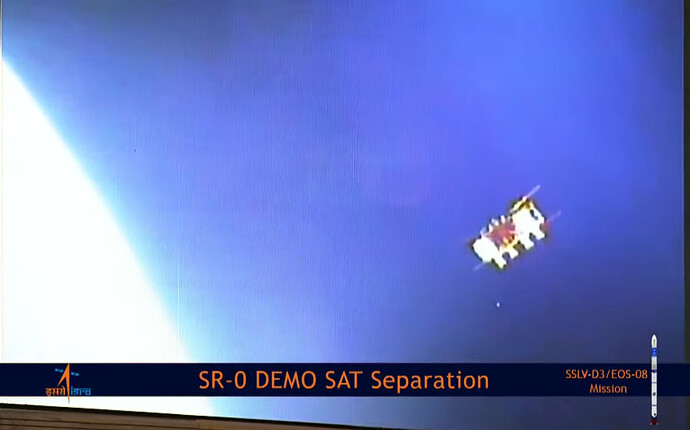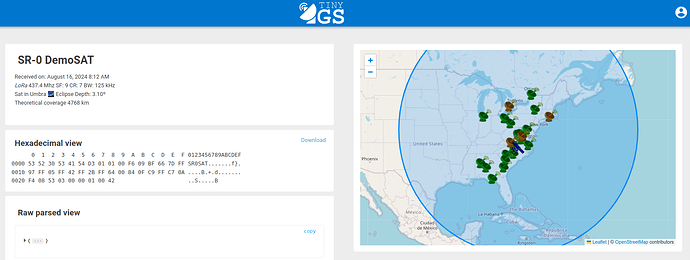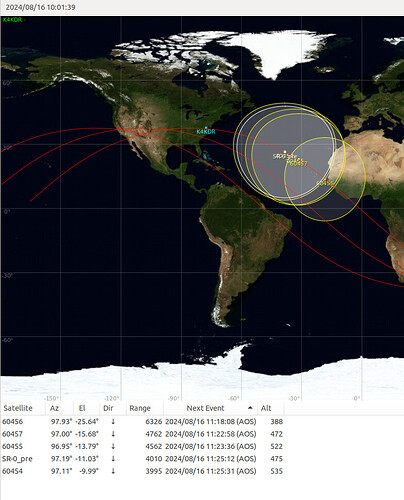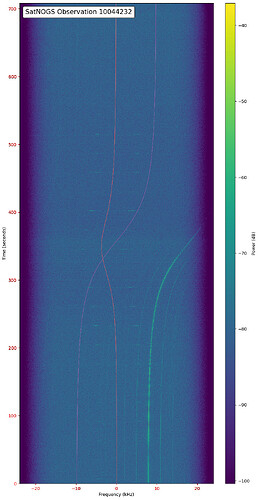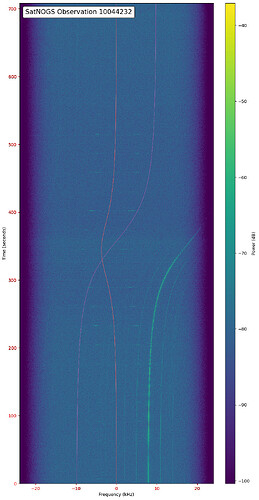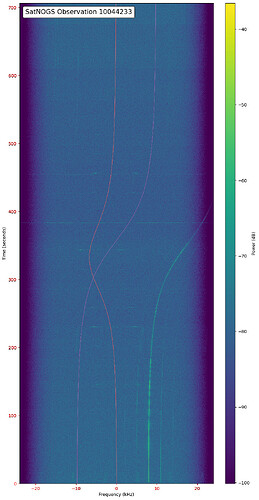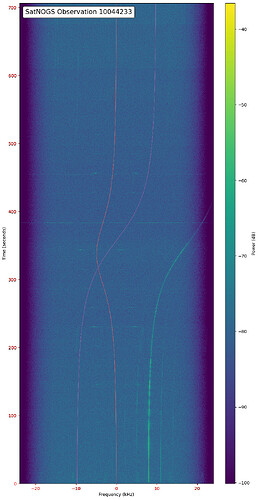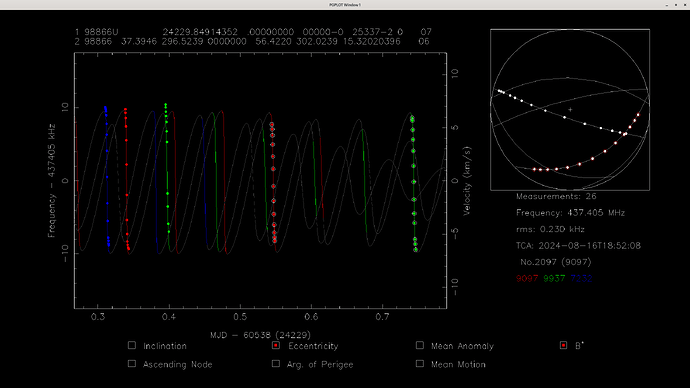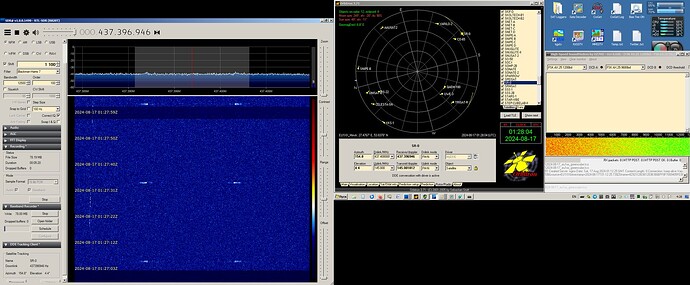SR-0 DemoSAT deployed successfully!
1 98866U 24229.16885417 .00000000 00000-0 50000-4 0 08
2 98866 37.3946 299.2305 0005544 342.3141 218.0000 15.31325089 05
./faketle -q 468.064223 -Q 475.658861 -I 37.394644 -n 299.230504 -w 342.314137 -m 218.00 -t 2024-08-16T04:03:09 -i 98866
I finally joined the (large) list of tinyGS station getting clean LoRa decodes from SR-0, but at 100mW TX power, the FSK beacons might require more antenna than I have. Will keep trying both modes, though!
FSK signals have been also received:
https://network.satnogs.org/observations/?future=0&good=1&bad=0&unknown=0&failed=0&norad=98866
First receptions around 2024-08-16 05:06 UTC in observations:
- SatNOGS Network - Observation 10044255 by “2459 - EA3GKP Taucho-Tenerife” station of EA3GKP
- SatNOGS Network - Observation 10044251 by “2271 - EIRSAT-1 GS - UCD Physics” station of @ucd_c-space
Great!! I looked earlier but there were none at the time yet.
Thanks for the alert - I’ll make sure the Team is aware.
======================
Ok, I was thinking you meant FSK “decodes”… I also saw FSK packets in my waterfall but not strong enough to decode - which appears to be the case on those two SatNogs observations as well. But that’s ok - still great that the FSK downlinks are being received!!
Those signals look pretty wide for 1k2 FSK, I tend to think these are LoRA frames.
Hi Jan!
The LoRa downlink packets from SR-0 are 125k wide.
So those would even be wider, curious these signals in the waterfall, do they look similar to the ones you used from the pre launch IQ recording?
Here a comparison INS-2TD 1k2 FSK SatNOGS Network - Observation 6491453
It seems SR-0 is in 9k6 mode.
A TLE set that fits a little better the current orbit, a more accurate one will follow:
SR-0
1 98866U 24229.16885417 .00000000 00000-0 50000-4 0 08
2 98866 37.3946 299.2305 0005544 342.3141 217.8616 15.31325089 05
I only had audio 1k2 sample files, so I don’t know. But you’re absolutely correct - it could be in 9k6 mode by mistake. Will check both rates if I get enough SNR one of these passes!
No better SNR on the 2nd nearly overhead pass of SR-0 tonight. The Team will likely switch the radio to the 1-watt downlink option at some point, so that should work much better for FSK whether it’s 1k2 or 9k6.
BUT, Space-Track has added -4- objects that line up nicely with this orbit:
SR-0_pre
1 98866U 24229.16915394 .00000000 00000-0 50000-4 0 06
2 98866 37.3946 299.2305 0005544 342.3141 218.0000 15.31325089 05
60454
1 60454U 24147A 24229.33667148 -.24999360 00000-0 -11450+1 0 9999
2 60454 37.3940 298.3182 0057903 339.7732 66.5482 15.27328733 22
60455
1 60455U 24147B 24229.33651731 -.20359273 00000-0 -67914+0 0 9995
2 60455 37.4008 298.2959 0071950 332.9219 75.5711 15.34848233 17
60456
1 60456U 24147C 24229.33376800 -.00000141 00000-0 00000+0 0 9994
2 60456 36.7021 296.7344 0002000 241.8333 162.4276 15.59389300 26
60457
1 60457U 24147D 24229.27565233 -.00000139 00000-0 00000+0 0 9995
2 60457 37.3655 298.5644 0030893 340.7502 91.2708 15.37476348 11
… so, now to just figure out which one is SR-0!
The passes are below my elve for now and out of the foot print
That’s interesting none of them seems to fit good the SR-0 observations. I’ve generated and I’m going to use for now this TLE set in DB and Network:
SR-0
1 98866U 24229.42293981 .00000000 00000-0 50000-4 0 06
2 98866 37.3946 297.4880 0005544 58.2073 107.0914 15.34503148 08
sr0_229_v3.dat (1.4 KB)
sites.txt (7.1 KB)
EDIT:
I may be wrong on the fits I’ve checked against the space-track.org TLE sets… I’ll continue to check and update with a new post.
So, the space-track.org TLE seems to fit well first observations, and especially OBJECT B (60455). However it doesn’t fit well the last ones. I’m adding bellow ikhnos results for two observations using my TLE set in the previous post against 60455 from space-track:
Older observation:
Observation 10044232 - 60455:
Observation 10044232 - Generated TLE:
Newer observation, same station, ~90min later:
Observation 10044233 - 60455:
Observation 10044233 - Generated TLE::
In the second one you see that the red line following 60455 TLE set doesn’t fit very well the signal.
TBA seems to be that currently there is a lot of changes in determining the right TLE set.
Lets keep an eye on the space-trak TLE changes.
With the latest observations in some cases the 60455 Object fits better than the current generated TLE sets, in other cases it doesn’t. I’m going to change the NORAD ID we follow for SR-0 to 60455 but until we have a new TLE from space-track.org I’m going to use the generated TLE below:
SR-0
1 98866U 24229.57403935 .00000000 00000-0 -67914+0 0 02
2 98866 37.4008 297.4461 0077392 60.3104 217.5884 15.26015000 01
sites.txt (7.1 KB)
sr0_229_v5.dat (1.8 KB)
New TLE set for SR-0:
SR-0
1 98866U 24229.84914352 .00000000 00000-0 00000-0 0 05
2 98866 37.3946 296.5239 0005271 56.4220 302.0239 15.32020396 01
sr0_229_v8.dat (2.3 KB)
sites.txt (7.1 KB)
We have assigned TLE sets by space-track.org, however these are the same with the TBA TLE sets they initially published.
0 OBJECT A
1 60454U 24147A 24229.33667148 -.24999360 00000-0 -11450+1 0 9999
2 60454 37.3940 298.3182 0057903 339.7732 66.5482 15.27328733 22
0 OBJECT B
1 60455U 24147B 24229.33651731 -.20359273 00000-0 -67914+0 0 9995
2 60455 37.4008 298.2959 0071950 332.9219 75.5711 15.34848233 17
0 OBJECT C
1 60456U 24147C 24229.33376800 -.00000141 00000-0 00000+0 0 9994
2 60456 36.7021 296.7344 0002000 241.8333 162.4276 15.59389300 26
0 OBJECT D
1 60457U 24147D 24229.27565233 -.00000139 00000-0 00000+0 0 9995
2 60457 37.3655 298.5644 0030893 340.7502 91.2708 15.37476348 11
Strangely none of them fits with the SR-0 signal we get. This could mean one of the two:
- The signal isn’t SR-0 and we try to track a wrong objects with the right TLE sets
- The signal is SR-0 and something goes wrong with the TLE space-track.org published
For the first case I’ve check the signals against known sources/satellites that transmit near SR-0 frequency, none of them fits though. So, if there isn’t an unknown object that transmits at that frequency, then this case is not our case. This is also supported by the fact, if I don’t make a mistake, that this orbit is not a very common one, so we don’t expect to find many satellites with this specific frequency at this specific orbit. Finally one more evidence is that using our TLE sets in tiny.gs they receiving LoRa frames (thanks @PE0SAT for point this).
So, we need to examine the second case, checking in nasaspaceflight forum, Jonathan McDowell (@planet4589) has pointed out that with spacetrack’s TLE sets the orbit is kind of elliptical (SSLV D3 : EOS-08 and SR-0 : FLP : 16 August 2024 (03:47 UTC)) but another user, cosmin penguin, points out that the data from the launch stream show that the orbit was the expected almost circular one (SSLV D3 : EOS-08 and SR-0 : FLP : 16 August 2024 (03:47 UTC)). These evidence probably show that there is a great chance space-track has done something wrong with calculations of the TLE.
Given the above, I decided to remove following object 60455 for SR-0 and continue produce and following TLE based on the received singal on our observations at least until we have newer versions from space-track.org.
@riftron it would be very very useful if you can confirm that the singal we see is indeed SR-0, as it is not the expected FSK1k2.
